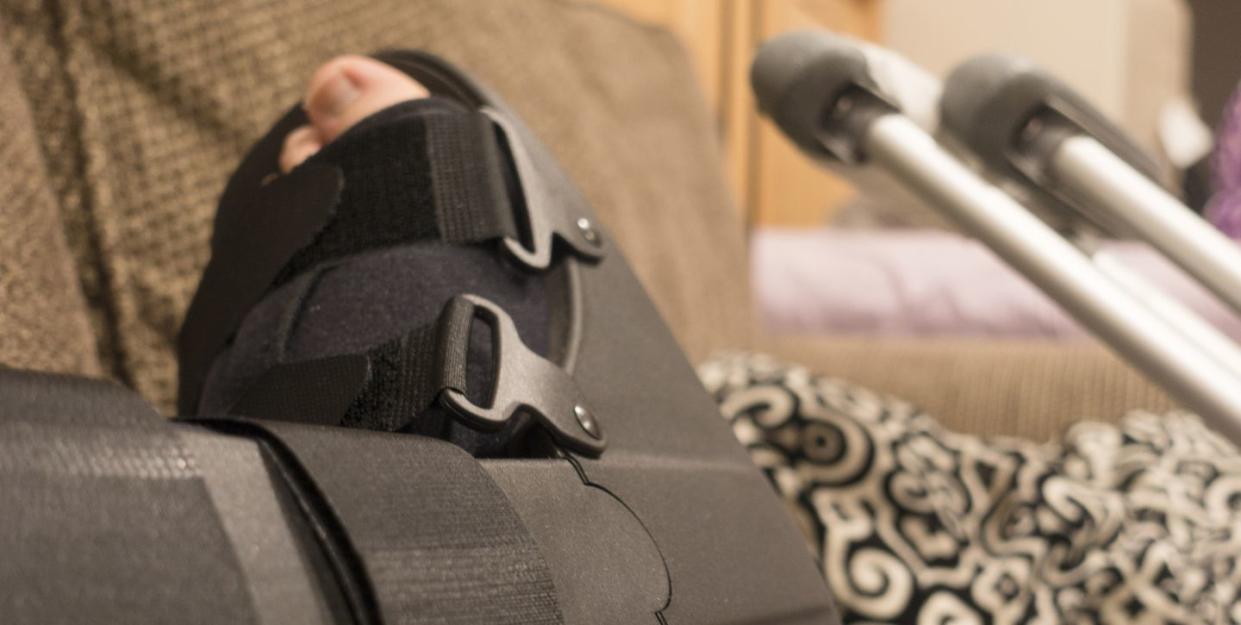You Can Still Maintain Muscle Mass in an Injured Limb

According to new research published in the Scandinavian Journal of Medicine & Science in Sports, if you’re dealing with an injury that leaves one limb immobilized in a cast or boot, training the opposite limb while you recover could help you maintain muscle mass for both.
It’s important to note that for some kinds of injuries, like tendonitis, you’ll actually want to focus on training the injured limb. But for injuries like fractures, training the opposite limb may be helpful.
If you’re dealing with an injury that leaves one limb immobilized in a cast or boot, good news: Training the opposite limb while you recover could help you maintain muscle mass in both limbs, new research suggests.
Published in the Scandinavian Journal of Medicine & Science in Sports, the study involved 30 participants who had one arm restricted for a minimum of eight hours a day for four weeks. They were assigned to one of three groups: One performed no exercise, a second did a mix of eccentric and concentric exercise, and the third did only eccentric exercise.
Join Bicycling today to become a stronger, faster cyclist!
Quick training refresher: With eccentric movements, the contracting muscle lengthens, like when you’re lowering a dumbbell during biceps curls or easing back down in a sit-up. With concentric movements, the contracting muscle shortens, like when you’re raising the dumbbell up toward the shoulder during biceps curls or lifting up into the sit-up so your chest comes closer to your knees.
In the study, the group that did only eccentric exercises showed significant strength increases and less risk of muscle atrophy in the immobilized arm. For instance, those in the no-exercise group had a 28 percent muscle loss in the restricted arm after a month, but the eccentric group had only a 2 percent loss.
While the exact reason why this “cross-transfer or strength” isn’t fully known, the central nervous system probably plays a role, according to study coauthor Ken Nosaka, Ph.D., director of exercise and sports science at Edith Cowan University in Australia.
“Unilateral resistance training may activate neural circuits that modify the efficiency of motor pathways to the opposite limb,” he told Runner’s World.
Basically what this means is that your brain compensates by producing adaptations that stimulate the muscles, even if they aren’t actively being used. Previous research has indicated the same can be true for leg muscles as well, Nosaka told Runner’s World.
It’s been reported that the extent of the cross-transfer effect is approximately 30 to 50 percent of the trained, uninjured muscle, according to Nosaka, so there’s a greater the increase in the muscle strength of the untrained, injured limb.
And while the exact reason for why eccentric-only was superior is also still not fully known, Nosaka said it’s likely because eccentric-only contractions have greater capacity to generate force than concentric contractions. Using himself as an example, he noted that he can lower a dumbbell that’s 20 kilograms (44 pounds) in an eccentric contraction, but can only lift a dumbbell that’s 15 kilograms (33 pounds) in a concentric contraction.
In terms of the best approach for training, the type used in the recent study seems like a solid strategy, said Carol Mack, D.P.T., C.S.C.S. She told Runner’s World that the research showed that three to five sets of eight to 15 reps of eccentric contractions—with rest times of one to two minutes between sets—gave the most strength improvements in the opposite arm. That’s in contrast to a program that uses a single set of heavier weights, done for fewer reps.
However, she added that further studies need to be done to investigate the mechanisms and the effect of heavier loads. One other caveat she adds as a doctor of physical therapy: Don’t assume that because your arm or leg is injured through an issue like tendonitis, you should focus on the other limb for a while.
“For some kinds of injuries, you’ll actually want to focus on the limb that’s hurting,” she said. “Active movement is going to be the best thing for getting it healed. The type of training covered in these studies is best for a leg or arm that has to be completely immobilized due to something like surgery or fracture.”
The best takeaway? Don’t skip training while you heal, and if you’re unsure on the best approach, talk to your physical therapist.
You Might Also Like

